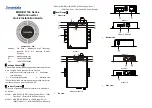
MODEL 2224-1
Technical Manual
Section 7
Ludlum Measurements, Inc.
Page 7-1
January 2012
Technical Principle of Operation
Refer to the Amplifier/Power Supply Board Schematic, Drawing 390
× 104, for the following:
Detector Input/ Amplifier
Negative-going detector pulses are coupled from the detector through C021
to amplifier U021. R023 and CR021 protects the input of U021 from
inadvertent shorts. Self-biased amplifier U021 provides gain in proportion to
R021 divided by R022. Transistor pins 4, 5, and 6 of U021 provides
amplification. Pins 12 and 15 of U021 are coupled as a constant current
source to pin 6 of U021. The output self-biases to 2 Vbe (approximately 1.4
volts) at pin 7 of U021. This provides just enough bias current through pin 6
of U021 to conduct all of the current for the constant current source.
Positive pulses from pin 7 of U021 are coupled to the discriminators
through R011 and C011.
Alpha/Beta Discriminator
Positive pulses from amplifier U021 are coupled to comparator U012, pin 6,
for alpha discrimination and pins 6 and 2 of U011 for beta discrimination.
R103, alpha threshold, provides the reference voltage for alpha comparator
U012. R106, beta threshold (defined as the lower threshold limit of the beta
counting window), provides the reference voltage for beta threshold
comparator pins 1, 2, and 3 of U011. R102, beta window (defined as the
upper threshold limit of the beta counting window), provides the reference
voltage for the beta window comparator pins 5, 6, and 7 of U011.
Alpha/Beta Discriminator Logic Circuit
Alpha pulses from U012 are coupled to univibrator U111. Pulses at pin 6 of
U111 are inverted by Q111 for connection to reset (R) pins 3 and 13 of
U101. Pin 9 of U111 provides the pulses to be counted by the
microprocessor (
μ
P). Pulses from pin 9 of U111 are connected to pin 3 of
Section
7
















































